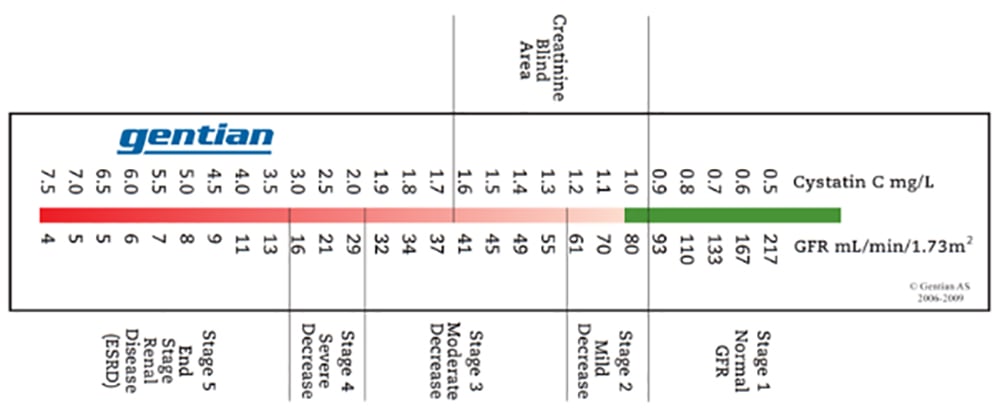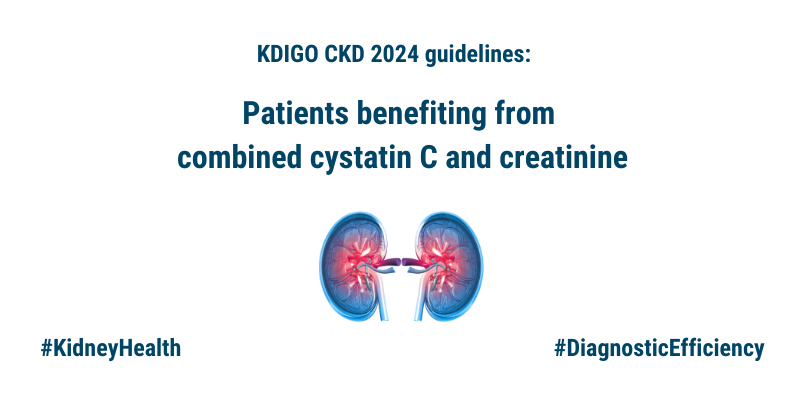
"Serum and plasma cystatin C measurement - a fast, easy and reliable estimation of renal function"
Glomerular Filtration Rate (GFR) measures the rate water and dissolved substances are filtered out of the blood per unit time. Hence GFR indicates level of kidney function.
GFR and cystatin C
Cystatin C is effectively filtered by the glomerulus and fully reabsorbed and broken down by the renal tubules for recycling. A raised level of serum or plasma cystatin C correlates closely with the GFR. Cystatin C therefore acts as an excellent indicator of reduced kidney function. The relationship between cystatin C level and GFR is valid over the whole range of kidney function observed in the human body [1].
The cystatin C concentration in serum/plasma is uninfluenced by age, gender and muscle mass. For this reason, several studies claim that cystatin C is a better GFR marker than for example creatinine, especially within in the creatinine-blind range [2-5].
The creatinine blind area
Serum creatinine values are not a direct measure of GFR. Creatinine values are dependent on variables including age and body mass, which must be corrected for when calculating the GFR. Importantly, GFR can be reduced by as much as 50% while the serum creatinine value is still within the normal range – this is what is called the “creatinine-blind area” that is visualised in the Gentian Cystatin C ruler below.
GFR - Kidney Disease Classification and the Gentian Cystatin C Ruler
NKF-KDIGO Guideline; GFR Categories in Chronic Kidney Disease [6,7]
| Normal | Healthy kidneys - normal GFR | GFR > 90 mL/min/1.73m2 |
| G1 | Kidney damage with normal or elevated GFR | GFR > 90 mL/min/1.73m2 |
| G2 1 | Kidney damage and mild decrease in GFR 2 | GFR of 60 - 89 mL/min/1.73m2 |
| G3a | Mild to moderate decrease in GFR | GFR of 45 – 59 mL/min/1.73m2 |
| G3b | Moderate to severe decrease in GFR | GFR 30 – 44 mL/min/1.73m2 |
| G4 | Severe decrease in GFR | GFR 15 – 29 mL/min/1.73m2 |
| G5 | Kidney failure - End Stage Renal Disease (ESRD) | GFR < 15 mL/min/1.73m2 |
1In the absence of evidence of kidney damage, neither Stage 1 nor Stage 2 fulfill the criteria for Chronic Kidney Disease, CDK
2 Relative to young adult level
The Gentian Cystatin C ruler shows the relationship between GFR and the level of serum cystatin C. It also shows the creatinine blind area the stages of kidney disease as classified by the NKF-KDIGO Guideline:

The ruler shows the range for:
- GFR levels indicating normal renal function (green)
- GFR levels indicating reduced renal function (red)
- The creatinine blind area
The Gentian Cystatin C Immunoassay
The Gentian Cystatin C Immunoassay is FDA510(k) cleared and CE-marked. The Gentian Cystatin C Immunoassay is a Particle-Enhanced Turbidimetric Immunoassay (PETIA) for in vitro diagnostic testing of cystatin C in human plasma and serum samples. The Gentian Cystatin C Immunoassay is rapidly performed in only 10 minutes and can be applied on a wide range of clinical chemical analysers with documented high inter instrument accuracy [8].
References
- Newman DJ et al. Serum cystatin C measured by automated immunoassay: a more sensitive marker of changes in GFR than serum creatinine. Kidney Int 1995;47:312–8
- Laterza OF et al. Cystatin C: an improved estimator of glomerular filtration rate? Clin Chem 2002, 48:5;63-99
- Grubb A. Cystatin C–properties and use as diagnostic marker. Adv Clin Chem 2000;35:63–99
- Kyhse-Andersen Jet al. Serum cystatin C, determined by a rapid, automated particle-enhanced turbidimetric method, is a better marker than serum creatinine for glomerular filtration rate. Clin Chem 1994;40:1921-1926
- Shemesh O et al. Limitations of creatinine as a filtration marker in glomerulopathic patients. Kidney Int 1985; 28: 830-38KDIGO CKD Work Group. KDIGO 2012 clinical practice guideline for the evaluation and management of chronic kidney disease. Kidney Int Suppl 2013; 3: 1–150
- National Kidney Foundation. K/DOQI clinical practice guidelines for chronic kidney disease: evaluation, classification, and stratification. Am J Kidney Dis 2002; 39: S1–S266
- Flodin M et al. Evaluation of Gentian Cystatin C reagent on Abbott Ci8200 and calculation of glomerular filtration rate expressed in mL/min/1.73 m(2) from the cystatin C values in mg/L. Scand J Clin Lab Invest. 2007;67(5):560-7. https://www.ncbi.nlm.nih.gov/pubmed/17763193
- Bargnoux AS et al. Clin Chem. 2017;63:833-841


